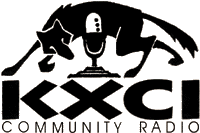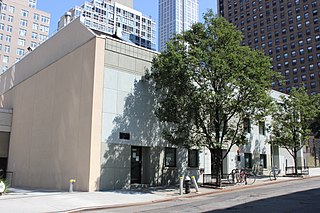Related Research Articles
A television network or broadcaster is a telecommunications network for distribution of television program content, where a central operation provides programming to many television stations or pay television providers. Until the mid-1980s, television programming in most countries of the world was dominated by a small number of terrestrial networks. Many early television networks evolved from earlier radio networks.
Public broadcasting involves radio, television and other electronic media outlets whose primary mission is public service. In many countries of the world, funding comes from governments, especially via annual fees charged on receivers.
A non-commercial educational station is a radio station or television station that does not accept on-air advertisements, as defined in the United States by the Federal Communications Commission (FCC) and was originally intended to offer educational programming as part, or whole, of its programming. NCE stations do not pay broadcast license fees for their non-profit uses of the radio spectrum. Stations which are almost always operated as NCE include public broadcasting, community radio, and college radio, as well as many religious broadcasting stations. Nearly all Non-Commercial radio stations derive their support from listener support, grants and endowments, such as the governmental entity Corporation for Public Broadcasting (CPB) that distributes supporting funds provided by the congress to support Public Radio.
Public-access television is traditionally a form of non-commercial mass media where the general public can create content television programming which is narrowcast through cable television specialty channels. Public-access television was created in the United States between 1969 and 1971 by the Federal Communications Commission (FCC), under Chairman Dean Burch, based on pioneering work and advocacy of George Stoney, Red Burns, and Sidney Dean.
TV3, owned and operated by Medford Community Cablevision, Inc., is a public-access television channel serving Medford, Massachusetts. It was created by mandate of the 1984 Cable Franchise Policy and Communications Act. The channel's current facilities are located at 5 High Street, under then-U.S. Representative Ed Markey's office in Medford Square. Medford Community Cablevision oversees the community's public access television on Comcast channel 3. It functions as both a production facility as well as a telecast station. In 2010 the station unveiled new services to the community including video on demand and 24/7 streaming video services on its website.

KAZT-TV, virtual and VHF digital channel 7, is an independent television station licensed to Prescott, Arizona, United States, and serving the Phoenix television market. The station is owned by the Londen family of Phoenix, and as such, is the only locally owned commercial English-language television station in the Phoenix market. KAZT's studios are located on Tower Road in Prescott, with a secondary studio and sales office in the Londen Center on Camelback Road in Phoenix. Its main transmitter is located atop Mingus Mountain. Its signal is relayed through a network of five low-power translators across central and northern Arizona, including Class A station KAZT-CD in Phoenix. The station is also carried on cable providers throughout the Phoenix market, as well as on the Phoenix DirecTV and Dish Network local feeds.

WCET, virtual channel 48, is a Public Broadcasting Service (PBS) member television station licensed to Cincinnati, Ohio, United States. The station is owned by the Greater Cincinnati Television Educational Foundation, a subsidiary of Public Media Connect. WCET was the first licensed public television station in the United States. Its studios are located in the Crosley Telecommunications Center on Central Parkway in Cincinnati, and its transmitter is located on Chickasaw Street in the Mount Auburn section of Cincinnati. Master control operations are based at the studios of sister PBS member station WPTD in Dayton.
Rogers TV is a group of English-language community channels owned by Rogers Communications. Many of these channels share common programs. Rogers TV broadcasts in the Canadian provinces of New Brunswick, Newfoundland and Labrador and Ontario. Rogers TV is available only in communities served by Rogers' cable and telecom division, and is not carried by other television service providers. Its French counterpart is TV Rogers.
KMSB, virtual channel 11, is a Fox-affiliated television station licensed to Tucson, Arizona, United States. The station is owned by McLean, Virginia-based Tegna Inc., as part of a duopoly with MyNetworkTV affiliate KTTU ; Gray Television, which owns CBS affiliate KOLD-TV, operates KMSB and KTTU under a shared services agreement (SSA). The stations share studios on North Business Park Drive on the northwest side of Tucson. KMSB's transmitter is located atop Mount Bigelow; as a result of the transmitter's location, residents in the northern part of Tucson, Oro Valley and Marana do not receive adequate reception of the station.

KVOA, virtual channel 4, is an NBC-affiliated television station licensed to Tucson, Arizona, United States. The station is owned by Allen Media Broadcasting, a subsidiary of Los Angeles-based Entertainment Studios. KVOA's studios are located on West Elm Street north of downtown Tucson, and its transmitter is located atop Mount Bigelow, northeast of Tucson. The station has two low-power translators: K04QP-D in Casas Adobes, Arizona and K28OY-D in Sierra Vista, Arizona.
Community television in Canada is a form of media that carries programming of local community interest produced by a cable television company and by independent community groups and distributed by a local cable company.

KOLD-TV, virtual channel 13, is a CBS-affiliated television station licensed to Tucson, Arizona, United States. The station is owned by Atlanta-based Gray Television, which also operates Fox affiliate KMSB and MyNetworkTV affiliate KTTU under a shared services agreement (SSA) with owner Tegna Inc. The three stations share studios on North Business Park Drive on the northwest side of Tucson, which also once housed the Raycom Design Group, an in-house firm that designed graphics packages for Raycom Media's television stations. KOLD-TV's transmitter is located atop Mount Bigelow. The station also operates a fill-in translator on VHF channel 13, whose transmitter is located atop the Tucson Mountains west of Tucson.

Shaw Spotlight is the name of locally based community channel services operated by cable TV provider Shaw Communications. The channels are available only to Shaw Cable subscribers and are produced in communities throughout western Canada.
WWTO-TV, virtual channel 35, is a Trinity Broadcasting Network (TBN) owned-and-operated television station serving Chicago, Illinois, United States, that is licensed to Naperville. It is sister to Plano-licensed TBN Inspire owned-and-operated station WLPD-CD. The two stations share studios on Vision Court in Aurora and transmitter facilities in Glen Ellyn, near the campus of the College of DuPage.

KUAT-TV, virtual channel 6, is a Public Broadcasting Service (PBS) member television station licensed to Tucson, Arizona, United States. Owned by the Arizona Board of Regents and operated by the University of Arizona, it broadcasts from studios in the Modern Languages Building on the U of A campus. KUAT's transmitter is located atop Mount Bigelow.

KXCI is a nonprofit "community radio" radio station that serves Tucson, Arizona. KXCI broadcasts on the frequency of 91.3 MHz. Programs include talk shows, music shows and call-in shows. The call letters come from the Roman numeral for 91—XCI.

Manhattan Neighborhood Network (MNN) is an American non-profit organization that broadcasts programming on five public-access television cable TV stations in Manhattan, New York City. The country’s largest community media center, MNN operates two community media centers – in midtown Manhattan and East Harlem – and provides education, equipment, facilities, and programs to community producers and organizations who want to create programming to air on one of MNN's five channels. In 2016, MNN will post more than 5,000 enrollments in their media classes, making one of the largest media education institutions in New York City.
Seattle Community Access Network (SCAN) is one of the Public, educational, and government access (PEG) cable television channels in Seattle, Washington. The station provides camera equipment, television studios and training that allow residents of King County to create and cablecast their own television shows for a small fee. The station is carried on Comcast and Broadstripe cable systems in King County and the greater Puget Sound region except for six cities covered by Puget Sound Access.
YurView Arizona is an American cable television channel serving Phoenix, Arizona, United States. The station is owned by Cox Communications. The station's studio facilities are located on the northwest end of Phoenix. The transmission signal is available to Cox cable television subscribers in central and southern Arizona, which includes the Phoenix and Tucson metro areas. It is on channel 4 on Cox's Phoenix-market systems and channel 7 on Cox's systems in southern Arizona.
NewTV is Newton, Massachusetts’ community media center, paid for by taxes on local cable bills.
References
- 1 2 "'The Great Satan at Large': The filthiest TV show of all time". 20 June 2011.
- ↑ "The Prescott Courier - Google News Archive Search".
- ↑ Boegle, Jimmy. "Welcome to Best of Tucson® 25: Super Tucson". Tucson Weekly. Retrieved 2017-11-14.
- ↑ "Access Tucson plans to close doors, go dark".
- ↑ "Access Tucson proposal misses deadline for city funding".
- ↑ "About Us".
- ↑ "Summer 2016 - Access Tucson". Access Tucson. 2016-07-18. Retrieved 2017-11-14.
- ↑ "Security Check Required". www.facebook.com. Retrieved 2017-11-14.
- ↑ "Digital Library".
- ↑ "About - Creative Tucson". creativetucson.org. Archived from the original on 2017-11-15.
- ↑ "Channel 20 - TV Schedule - Creative Tucson". creativetucson.org. Archived from the original on 2017-11-15.